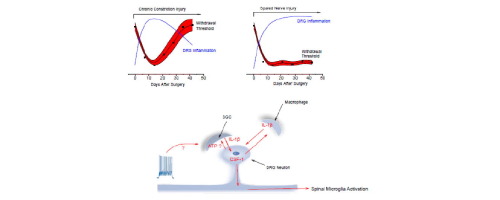当前位置:
X-MOL 学术
›
Neuroscience
›
论文详情
Our official English website, www.x-mol.net, welcomes your feedback! (Note: you will need to create a separate account there.)
Time Course of Inflammation in Dorsal Root Ganglia Correlates with Differential Reversibility of Mechanical Allodynia.
Neuroscience ( IF 3.3 ) Pub Date : 2020-01-07 , DOI: 10.1016/j.neuroscience.2019.12.040 Myung-Chul Noh 1 , Benjamin Mikler 1 , Twinkle Joy 1 , Peter A Smith 2
Neuroscience ( IF 3.3 ) Pub Date : 2020-01-07 , DOI: 10.1016/j.neuroscience.2019.12.040 Myung-Chul Noh 1 , Benjamin Mikler 1 , Twinkle Joy 1 , Peter A Smith 2
Affiliation

|
Some individuals recover from the pain of nerve trauma within 12 months or less whereas others experience life-long intractable pain. This transition between reversible pain and the establishment of chronic neuropathic pain is poorly understood. We examined the role of persistent inflammation in the dorsal root ganglia (DRG) in the long-term maintenance of mechanical allodynia; an index of neuropathic pain. Male Sprague-Dawley rats underwent chronic constriction injury (CCI), spared nerve injury (SNI) or sham surgery. Both CCI and SNI animals displayed robust mechanical allodynia in the ipsilateral paw at 7 d post-surgery; however, only SNI animals maintained mechanical allodynia at 42 d post-surgery. DRGs were extracted at 7 d or 42 d post-surgery to assess inflammation via rt-qPCR or immunohistochemistry to measure colony stimulating factor 1 (CSF1) expression, satellite glial cell (SGC) activation, presence of Iba1 positive macrophages and interleukin1 β (IL-1β) mRNA levels. Whereas DRGs from SNI animals continued to display inflammatory markers at 42 d, those from CCI animals did not. Moreover, the level of allodynia displayed by each individual animal correlated with the extent of DRG inflammation. These data support the hypothesis that the amount of CSF1 immunoreactivity and the persistence of inflammation in ipsilateral DRGs contribute to the difference between transient and persistent mechanical allodynia observed in the CCI and SNI models. We also suggest that feedback loops involving cytokines and neurotransmitters may contribute to increased DRG activity in chronic neuropathic pain. Consequently, targeting persistent CSF1 production and peripheral neuroinflammation may be an effective approach to the management of chronic neuropathic pain.
中文翻译:

背根神经节炎症的时程与机械性异常性疼痛的差异可逆性相关。
有些人会在12个月或更短的时间内从神经创伤的痛苦中恢复过来,而另一些人则终生难忘的痛苦。人们对可逆性疼痛与慢性神经性疼痛的建立之间的这种过渡知之甚少。我们研究了持续性炎症在背根神经节(DRG)中对机械性异常性疼痛的长期维持;神经性疼痛的指标。雄性Sprague-Dawley大鼠经历了慢性收缩损伤(CCI),神经损伤(SNI)或假手术。术后7 d,CCI和SNI动物均在同侧爪中表现出强健的机械异常性疼痛。但是,只有SNI动物在术后42 d保持机械性异常性疼痛。在术后7或42 d提取DRG,通过rt-qPCR或免疫组织化学评估炎症,以测量集落刺激因子1(CSF1)表达,卫星胶质细胞(SGC)活化,Iba1阳性巨噬细胞和白介素1β(IL)的存在-1β)mRNA水平。来自SNI动物的DRG在第42天继续显示出炎症标记,而来自CCI动物的DRG没有。此外,每只动物表现出的异常性疼痛水平与DRG炎症程度相关。这些数据支持这样的假设,即同侧DRG中CSF1免疫反应的数量和炎症的持续性是造成CCI和SNI模型中观察到的短暂性和持续性机械性异常性疼痛之间差异的原因。我们还建议涉及细胞因子和神经递质的反馈回路可能有助于增加慢性神经性疼痛中的DRG活性。因此,靶向持续的CSF1产生和周围神经炎症可能是治疗慢性神经性疼痛的有效方法。
更新日期:2020-01-07
中文翻译:

背根神经节炎症的时程与机械性异常性疼痛的差异可逆性相关。
有些人会在12个月或更短的时间内从神经创伤的痛苦中恢复过来,而另一些人则终生难忘的痛苦。人们对可逆性疼痛与慢性神经性疼痛的建立之间的这种过渡知之甚少。我们研究了持续性炎症在背根神经节(DRG)中对机械性异常性疼痛的长期维持;神经性疼痛的指标。雄性Sprague-Dawley大鼠经历了慢性收缩损伤(CCI),神经损伤(SNI)或假手术。术后7 d,CCI和SNI动物均在同侧爪中表现出强健的机械异常性疼痛。但是,只有SNI动物在术后42 d保持机械性异常性疼痛。在术后7或42 d提取DRG,通过rt-qPCR或免疫组织化学评估炎症,以测量集落刺激因子1(CSF1)表达,卫星胶质细胞(SGC)活化,Iba1阳性巨噬细胞和白介素1β(IL)的存在-1β)mRNA水平。来自SNI动物的DRG在第42天继续显示出炎症标记,而来自CCI动物的DRG没有。此外,每只动物表现出的异常性疼痛水平与DRG炎症程度相关。这些数据支持这样的假设,即同侧DRG中CSF1免疫反应的数量和炎症的持续性是造成CCI和SNI模型中观察到的短暂性和持续性机械性异常性疼痛之间差异的原因。我们还建议涉及细胞因子和神经递质的反馈回路可能有助于增加慢性神经性疼痛中的DRG活性。因此,靶向持续的CSF1产生和周围神经炎症可能是治疗慢性神经性疼痛的有效方法。



























 京公网安备 11010802027423号
京公网安备 11010802027423号